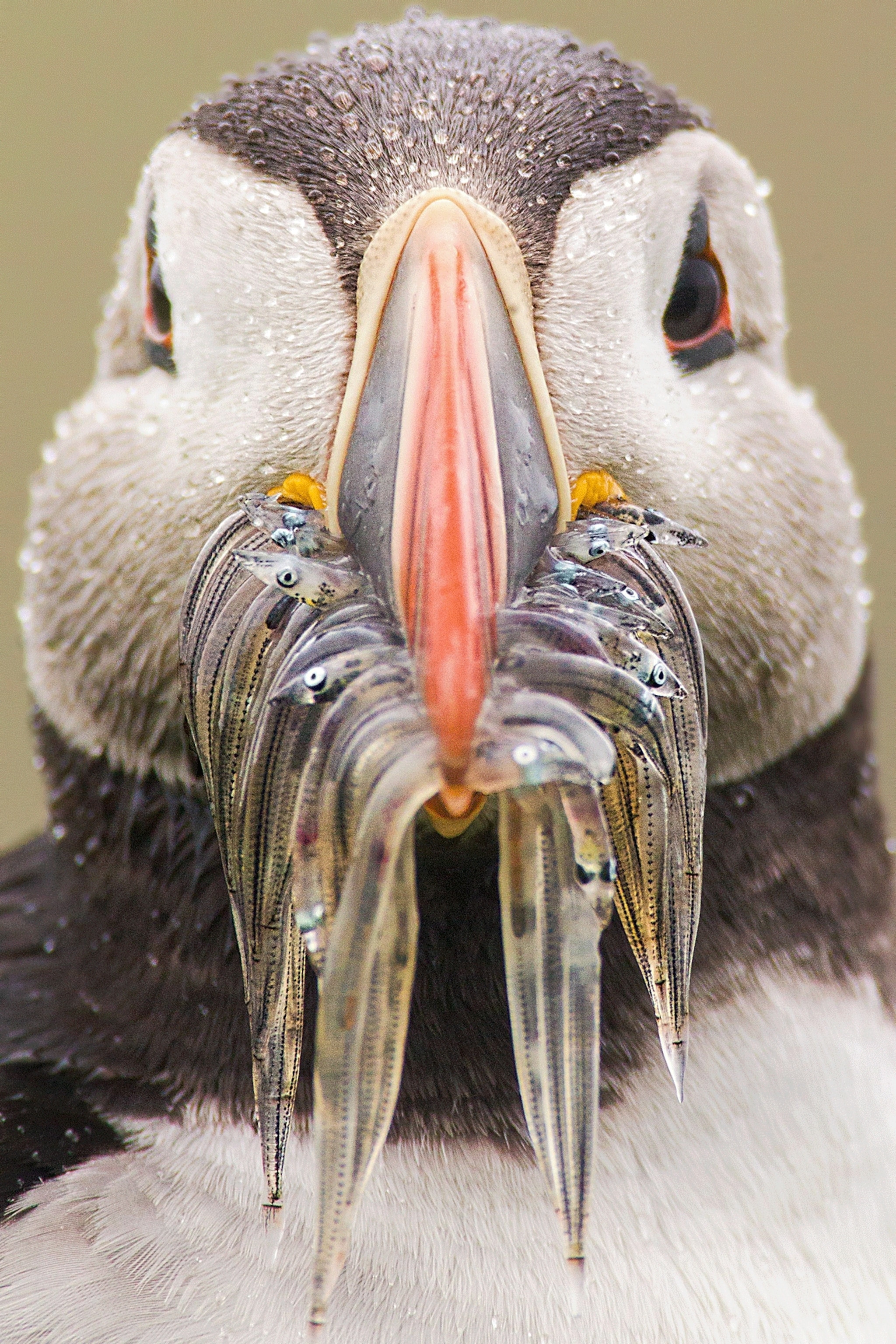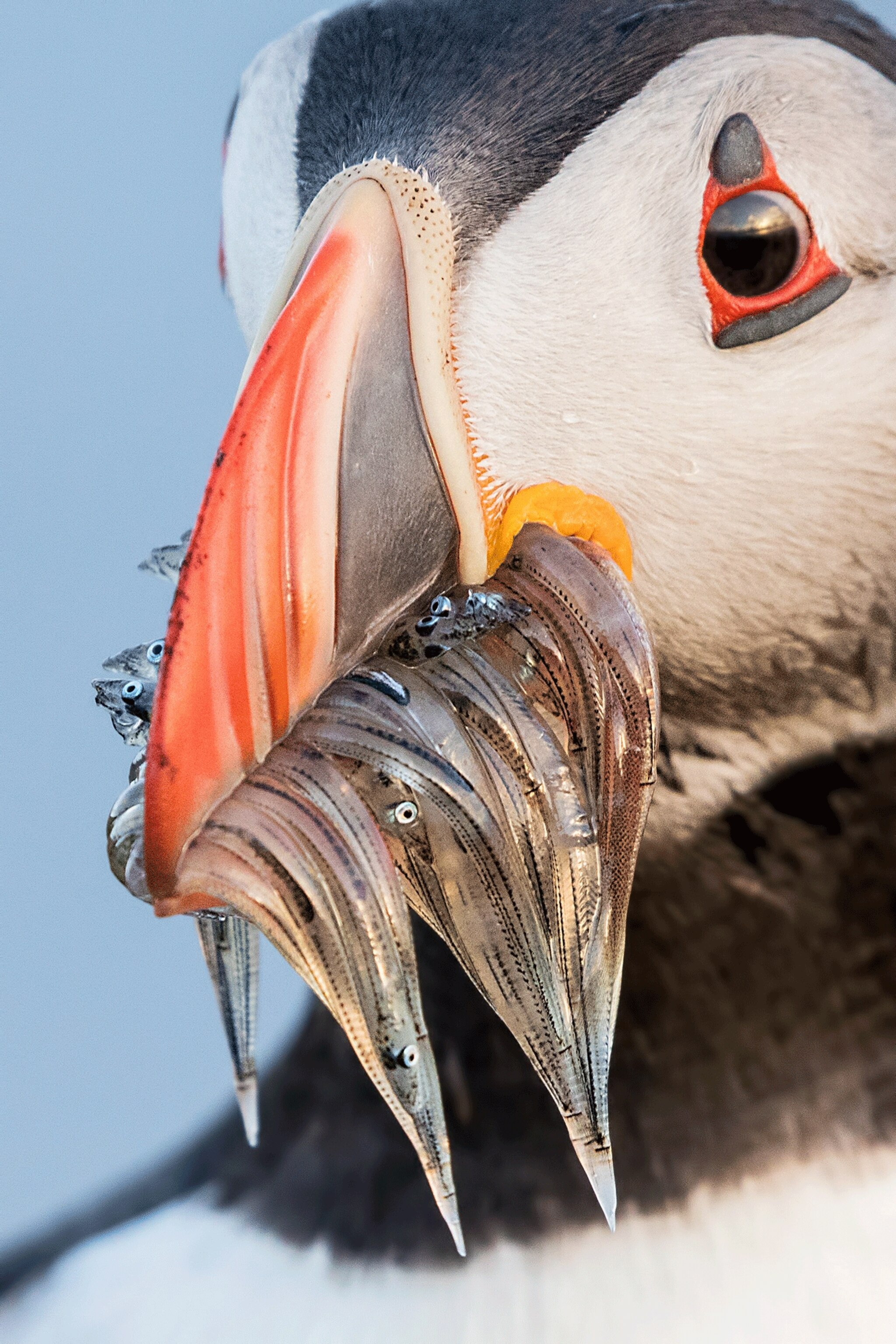
Behind the Stunning Photo of a Puffin Gorging on Fish
Discover the story behind this 2017 National Geographic Nature Photographer of the Year entry.
“I primarily photograph birds,” says National Geographic Your Shot photographer and computer engineer by day Sunil Gopalan. “I had photographed two other species of puffins (horned and tufted) before in Alaska, and the only one that was remaining on my list was the Atlantic puffin.”
Gopalan says this particular species of puffin can be found on both sides of the Atlantic Ocean, but he wanted to find a remote location to shoot photos of them—the less people the better. After conducting some research, he settled on the small island of Fair Isle off the coast of Shetland, in northern Scotland. (Watch a curious puffin befriend a human.)
Shetland’s website calls itself famous for its “birds, knitwear, and historic shipwrecks.” Fair Isle can only be reached by means of a four-hour ferry ride, or a small twin-engine plane, making it a relatively unfrequented, albeit ruggedly beautiful, destination.
Gopalan’s travels took him from the Midwestern United States to Glasgow to Sumburgh, where he boarded a small aircraft to his puffin paradise. While most of his time spent on the island yielded ideal weather, one rainy morning gave him the opportunity to capture something a bit different. Gopalan was thinking about eating breakfast when a rain-drenched puffin appeared carrying a meal of its own.
This was his moment to act, and he snapped photo after photo. The result: stunning portraits of the wild bird with a bountiful feast of tiny fish in its bill, making its way back to bring the haul to its hungry chick. He submitted his best shot online in hopes of being named the 2017 National Geographic Nature Photographer of the Year.

Atlantic puffins spend most of their lives at sea, returning to land only to form breeding colonies during spring and summer. The Atlantic puffin’s beak appears a dull shade of grey during winter, but it changes to a bright orange when spring returns. This change earns it a nickname of “sea parrot.”
When Gopalan visited Fair Isle in July, puffin mothers had already laid their eggs (usually one per nest) upon the rocky, North Atlantic cliffs. During this time, parents take turns feeding their chicks small fish that they catch in their spacious bills. (Watch a baby puffin perform its first solo swim.)
Extremely agile birds, Atlantic puffins steer through the water with rudderlike webbed feet, and dive to depths of up to 200 feet. They typically hunt small fish such as herring or sand eels, and they fly back to their nests at a rapid speed of 400 flaps per minute, reaching speeds up to 55 miles per hour. (See a video of young Icelandic puffins who were saved by children.)

The challenge of shooting speedy birds such as the Atlantic puffin is precisely what makes them his favorite photographic subject, and it drives Gopalan to travel as frequently as possible, to try to capture new species from around the world. He then submits his favorite images on Your Shot. Says Gopalan, “National Geographic is the gold standard for nature enthusiasts. I recall reading old copies of the magazine and imagining what it might be like to go on assignment.”
He says Your Shot is a great way to be involved in the photographic community, and that he is able to keep great company by interacting with other photographers on the platform. “That is the kind of inspiration that everyone needs in order to keep doing better, and the Nature Photographer competition is the highest of bars to aspire for,” he says.
See more of Sunil Gopalan’s work at http://www.sunilsphotos.com/
Think you have the winning photo? Enter your best nature photography for a chance to be named the 2017 National Geographic Nature Photographer of the Year.
Related Topics
You May Also Like
Go Further
Animals
- Orangutan seen using plants to heal wound for first timeOrangutan seen using plants to heal wound for first time
- What La Palma's 'lava tubes' tell us about life on other planetsWhat La Palma's 'lava tubes' tell us about life on other planets
- This fungus turns cicadas into zombies who procreate—then dieThis fungus turns cicadas into zombies who procreate—then die
- How can we protect grizzlies from their biggest threat—trains?How can we protect grizzlies from their biggest threat—trains?
Environment
- What La Palma's 'lava tubes' tell us about life on other planetsWhat La Palma's 'lava tubes' tell us about life on other planets
- How fungi form ‘fairy rings’ and inspire superstitionsHow fungi form ‘fairy rings’ and inspire superstitions
- Your favorite foods may not taste the same in the future. Here's why.Your favorite foods may not taste the same in the future. Here's why.
- Are the Great Lakes the key to solving America’s emissions conundrum?Are the Great Lakes the key to solving America’s emissions conundrum?
- The world’s historic sites face climate change. Can Petra lead the way?The world’s historic sites face climate change. Can Petra lead the way?
History & Culture
- Meet the ruthless king who unified the Kingdom of Hawai'iMeet the ruthless king who unified the Kingdom of Hawai'i
- Hawaii's Lei Day is about so much more than flowersHawaii's Lei Day is about so much more than flowers
- When treasure hunters find artifacts, who gets to keep them?When treasure hunters find artifacts, who gets to keep them?
Science
- Why ovaries are so crucial to women’s health and longevityWhy ovaries are so crucial to women’s health and longevity
- Orangutan seen using plants to heal wound for first timeOrangutan seen using plants to heal wound for first time
Travel
- Why this unlikely UK destination should be on your radarWhy this unlikely UK destination should be on your radar
- A slow journey around the islands of southern VietnamA slow journey around the islands of southern Vietnam
- Is it possible to climb Mount Everest responsibly?Is it possible to climb Mount Everest responsibly?
- 5 of Uganda’s most magnificent national parks
- Paid Content
5 of Uganda’s most magnificent national parks




